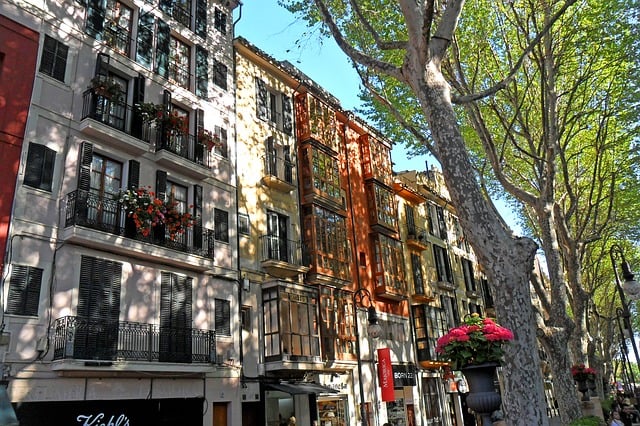[ad_1]
What is the latest?
There were high expectations that 2021 would be the year that property prices in Spain would come tumbling down.
This was forecast by different international credit agencies including Standards and Poor’s, who said the Iberian nation would go from being one of the countries where prices fall the most as a result of the coronavirus crisis in 2021, only to then be among the markets where housing will become more expensive in 2022.
Three months into the new year, there’s little evidence of a steep drop in prices so far.
In fact, according to consultancy firm Gesvalt, in the first quarter of 2021 Spanish property prices rose slightly in seven Spanish regions and are stabilising across the country.
If Spain’s tourism industry recovers some of its losses this summer and unemployment rates are kept low, it could be that the predicted drop in prices, especially that of second-hand homes, will not be as dramatic as expected.
Has the pandemic made it easier to get a mortgage in Spain?
It depends, largely on your work and financial situation. Spain’s National Statistics Institute recorded a drop of 7.6 percent in the number of mortgages approved in 2020.
This could be linked to a number of pandemic-related factors – not least Spain’s full two-month lockdown from March to May 2020 and rising joblessness – but there’s another factor.
As a result of the Spanish job market’s current instability, some banks are now stricter and more frugal when it comes to offering clients mortgages.
Civil servants and employees with permanent contracts at companies that haven’t been affected by the Covid crisis are among those that financial entities trust the most to pay back their hipotecas (mortgages in Spanish).
On the other hand, those who do meet the bank’s criteria can take advantage of the fact that interest rates in Spain are now at their lowest point in recent records, meaning more favourable mortgages for buyers.
“It’s a buyer’s market and a good time to buy property right now”, says real estate agent Raf Jacobs from Inspire Property Experts in Barcelona, who also runs a series of property webinars.
“Borrowing money has never been cheaper.”
READ MORE: Property in Spain: Why mortgages are now cheaper than ever
In January 2021, signed mortgages experienced a drop of 32 percent compared to stats from the same month in 2020, so the banks’ appealing offer doesn’t seem to have paid off yet.
“The data on mortgages for January shows the sluggishness with which the mortgage market has started this year, not so much because of the lack of interest from banks, which continue with a wide offer and at historically low rates, but rather due to the slower push in demand, as a result of the lengthening of mobility restriction measures and their impact on Spain’s economic outlook, explained Juan Villén, director of Spanish property website Idealista’s mortgages section.
“A recovery is not foreseeable in the short term, at least until we see a greater dynamism in the vaccination rate and the beginning of the relaxation of mobility restrictions ”.
How about if I have some money saved up?
The spike in layoffs and temporary dismissals (ERTE) has forced many families in Spain to tighten their belts or dip into savings to make ends meet.
For others who were lucky enough to keep working, the lack of mobility and general economic insecurity has meant they have managed to save up more than usual, with the latest data from the Bank of Spain showing that between January and September 2020, families in Spain achieved a ‘forced’ saving of around 2.5 percent of the country’s GDP.
These ahorros (savings in Spanish) are the other determining factor for budding homeowners.
So how much money do you need to put down as a deposit to get a mortgage for a home?
According to Spanish money website iAhorro, Spanish banks will expect you to put down at least 20 percent of the price of the property as a deposit. Price comparison site Rastreator estimates the ideal initial necessary savings before requesting a mortgage to be more around 30 percent of the value of the home, to cover transaction costs as well.
According to a recent study by iAhorro, it takes the average Spanish family seven years to save up enough to put an installment of 20 percent down on a property.
That’s based on the average Spanish salary of €1,641 per month for the last quarter of 2020, and the average price per square meter in Spain as a reference, which stands at €1,353, (according to appraisal company Tinsa) and the 50/20/30 rule, by which 50 percent of monthly income is allocated to basic expenses, 20 percent to savings and 30 percent to other personal expenses.
Photo: Nattanan Kanchanaprat/Pixabay
“More mortgage applications are rejected than before the pandemic, even from clients who, in principle, have a good profile,” says Miquel Riera, mortgage specialist at HelpMyCash.com .
The main requirements are having a stable income, having a job contract and handing over a sizeable deposit of 20 percent plus 10 percent in taxes to secure the mortgage and property.
Sometimes this can be €40,000, for more expensive properties €80,000.
Regional differences in salaries and property prices play a big role, meaning that in the Balearic Islands it takes around 14 years to pay a mortgage whereas in Extremadura it takes five years.
How much can I expect my mortgage to cost me after that?
That depends on a number of factors, including how much you pay when securing the property.
Spanish families pay on average €599 a month for their mortgages. There are big differences between the provinces- in Malaga and Mallorca homeowners pay 27 percent of their wages towards their mortgages whereas in Lugo (Galicia), Castellón (Valencia region), Murcia and Placencia the rate is less than 15 percent of the monthly salary.
It takes the average Spanish family 23 years and seven months to pay off their mortgage, so think long and hard if you will be able to take on that financial responsibility before signing on the dotted line.
Can I get a mortgage in Spain if I don’t have any savings?
Some banks gave mortgages of up to 90 percent or even 100 percent before the pandemic, but this trend seems to be slowly fading out.
According to the Bank of Spain, the percentage of mortgages of more than 80 percent represented 9.4 percent of the total during the first quarter of 2020, while in the same period of 2019 it was 13.1 percent.
Ana Botín, president of Banco Santander, showed interest in marketing mortgages for young people without savings – a replica of the British help to buy model – which consists of granting young people 95% mortgages with a state guarantee. This however is yet to come to fruition.
Meanwhile, rent-to-own schemes – which came to a halt when Spain’s real estate bubble burst in 2008 – are making somewhat of a return as private sellers are beginning to include this option in their ads to avoid having to lower the price of their homes.
Buyer and tenant can deduct the monthly rents, totally or partially, in the final price and not pay interest, because there is no debt, for the duration of the purchase option.

Apartment blocks in Mallorca. Photo: Bartłomiej Koc/Pixabay
“You have to justify a stable monthly income of at least three times the monthly rent, that you will have to pay during that period,” says José Antonio Montalbán, manager of AOC Consultora.
“More and more young people are asking us to find housing for them with this option.
“They are solvent, but they have not saved 30 percent or 40 percent of the property value, including the expenses of deeds and taxes.”
Small developers with problems selling their property stock are also turning to this model.
Should I carry on renting in Spain instead?
If you don’t have enough savings or fit the work profile banks require to offer you a mortgage, the silver lining is that rental prices are still falling in Spain in 2021.
According to Idealista’s figures for March 2021, the annual variation in rent prices was particularly pronounced in Barcelona (where they have fallen by 14.3 percent in one year), followed by Madrid (-10.7 percent), Palma (-8.7 percent), Valencia (-6.3 percent), Seville (-6.1percent) and Malaga (-5.3 percent).
Property analyst and Barcelona University economic lecturer Gonzalo Bernardos forecasts that rents will fall on average by 6 percent in 2021.
This means that budding homeowners who aren’t quite ready financially to own a property can potentially save on their rents in the meantime, and put more money aside for their dream home.
READ MORE:
[ad_2]
Source link